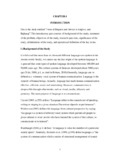Please use this identifier to cite or link to this item:
https://elibrary.tucl.edu.np/handle/123456789/1566| Title: | Forms of Request and Advice in English and Bajhangi |
| Authors: | Bhatta, Dev Raj |
| Keywords: | Forms of Request;Advice;Bajhangi;Rayal VDC |
| Issue Date: | 2017 |
| Abstract: | This research entitled “Forms of Request and Advice in English and Bajhangi” was carried out to find out the forms of request and advice used in English and Bajhangi language and to compare the forms of request and advice used in these languages. Bajhangi Language is compared the forms on the basis of the relationship with friends, shopkeepers, strangers, neighbors, parents, boss, relatives, sisters and brothers, and sons. The data were collected from Bajhangi native speakers of the Rayal VDC of Bajhang district. The data were collected with the help of questionnaire and interview schedule. The data for English were collected from Matreyek’s book, different thesis and dictionaries. The researcher found that in comparison to English speakers Bajhanginative speakers were less polite while requesting their intimate friends. Bajhanginative speakers used more polite forms to the strangers than to friends. They did not use impolite forms to their parents while requesting. The Bajhanginative speakers used polite forms of advice to the seniors, strangers and new friends but English speaker use same polite form of language. This study consists of five chapters. The first chapter deals with general background, statements of the problem, objectives of the study, research questions or hypothesis, significance of the study, delimitations of the study and operational definitions of the key terms. The second chapter deals with the review of theoretical and empirical literature and conceptual framework of the study. Likewise, the third chapter deals with the methodology adopted for the study in which, design of the study, sample of the study, sampling procedure, tools and process of data collection of the study are discussed. The fourth chapter deals with the analysis and interpretation of the collected data descriptively and using simple statistical tool; percentage. Similarly the fourth chapter also deals with the findings based on the analysis and interpretation of the data. The fifth chapter deals with the conclusion and implications of the study based on the findings of the study. This chapter is followed by reference and appendices. |
| URI: | http://elibrary.tucl.edu.np/handle/123456789/1566 |
| Appears in Collections: | English Language Education |
Files in This Item:
| File | Description | Size | Format | |
|---|---|---|---|---|
| cover pages.pdf | 203.08 kB | Adobe PDF |  View/Open | |
| New thesis.pdf | 374.07 kB | Adobe PDF |  View/Open |
Items in DSpace are protected by copyright, with all rights reserved, unless otherwise indicated.
